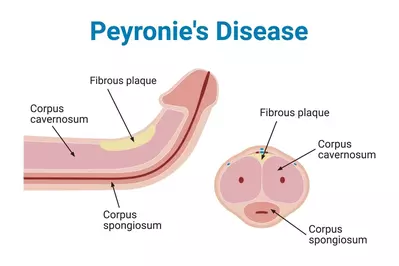On this episode of the Balls Deep podcast, we're diving — pun totally intended — into a subject that still scares a lot of guys to talk about yet touches way more men than most folks realize: Peyronie's disease (PD). Dr. Joe Pazona sits down with Ken Mitchell, a men's-health Physician Associate who has spent almost 30 years guiding men through everything from awkward bends to bedroom blowouts. Together they peel back the mystery of penile curves, explain why they happen, and walk listeners through the real solutions available today. Here’s what to know about Peyronie’s disease:
Not All Bends Are Bad: What's Normal, What's Not
Fact: not every curve is cause for alarm. Plenty of men are just put together with a tiny tilt, and as Ken says, nobody really comes out with a completely straight penis. A mild bend is absolutely normal as long as it isn’t painful and doesn’t interfere with sex.
But if that gentle arc suddenly deepens or starts hurting? That could signal the start of Peyronie’s disease.
What is Peyronie's Disease?

Picture the penis as a sausage. Within that sausage sit two main chambers flooded with blood and covered by a tight, elastic layer called the tunica albuginea. When arousal strikes, that layer stretches. Yet even a tiny, unnoticed injury — for example, grinding friction or a shaky thrust — can leave a small scar. Unlike skin, that patch stays rigid while the rest keeps growing.
As blood rushes in, the stiff area stops stretching and the shaft bends toward it. The result is a curve that can point up, down, left, or right. The injury itself may not be dramatic; it may simply follow not-so-great lubrication or a not-quite-firm erection during intercourse. Or, it could be an unforgettable "snap" during a missed thrust—cue the wincing.
Symptoms: It's Not Just the Curve
Most men spot these changes:
- A fresh or deepening bend when hard
- Nagging pain, especially early on
- A lump, ridge, or dense spot along the shaft
- A shorter, narrower shape sometimes nicknamed bottleneck or hourglass
- Occasional erectile dysfunction (ED)
And just to clear the air, Peyronie’s disease is not cancer. Still, it is a bona fide medical problem that can hammer a mans confidence, love life, and peace of mind.
Why Some Guys Get It & Others Don't

Nobody knows a single reason. If you lined up ten guys, kicked each in the groin (seriously, don’t), and only a handful ended up with PD, questions pile up. Answers hide in genetics, healing style, plus extra risks such as:
- Diabetes
- Erectile dysfunction
- Prostate cancer treatments
- Shaky metabolic health
Dr. Pazona sums it best: Healthy heart = healthy penis. When blood flow drops, inflammation climbs, and scars don't seal right, the stage gets set for Peyronie’s disease.
Can You Prevent Peyronie's Disease?
Total prevention isn’t realistic, but you can tilt the odds. Ken keeps it basic:
- Treat your erections like knees — don't let them bang, twist, or dry out.
- Stay sexually active — regular erections keep the tissues strong.
- Prioritize cardiometabolic health — eat clean, sleep well, jog or lift, manage stress.
- Avoid trauma — pick positions wisely and notice when a rise isn't full.
What to Do If You Suspect You Have Peyronie’s Disease

If something feels off, see a doctor. Waiting months or years rarely fixes anything. Meeting a urologist who studies sexual health can steer you toward the most effective options.
And nope, you’re not on this journey by yourself. Thanks to better awareness, more guys are raising their hands early — and that’s honestly great news.
Final Takeaways
Ok, quick refresh:
- A mild curve? Totally ordinary.
- A fresh, aching, or growing bend? Book a check-up.
- PD often comes from injury, especially in men with ED or poor metabolic health.
- The toll isn't just physical — it's mental and relational too.
- See a urologist early and take control of your penile health.
As Dr. Joe puts it, “If you’re not going to take care of your heart for heart reasons, do it for your penis.”
You’re all up to speed on everything you should know about Peyronie’s disease. If you’re suffering from curvature, there are some ways to straighten the penis.
Disclaimer: This blog is for informational purposes only and does not substitute professional medical advice. Always consult with your healthcare provider for personalized guidance.










